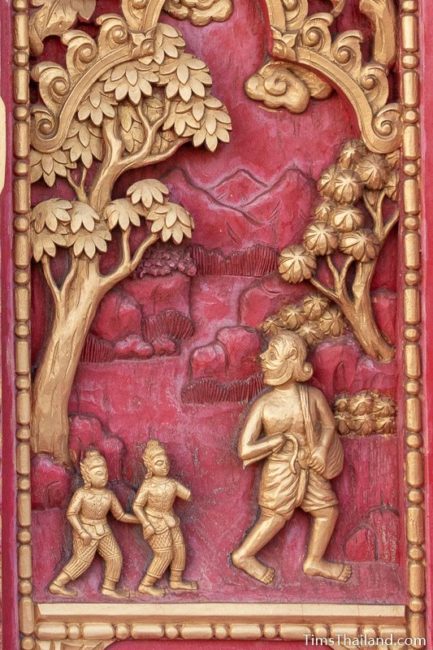อ่านภาษาไทยที่นี่ (Click here to read a Thai version.)
The carved wooden doors and window shutters on the seventh floor of Phra Mahathat Kaen Nakhon stupa at Wat Nong Wang tell the last ten Jataka tales. The artist was Tawon Gonkaew.
The Jataka tales (chah-dok in Thai) are a collection of 547 birth stories from the Pali Canon (the Buddhist equivalent of the Bible) recounting pre-enlightenment lives of the Bodhisatta (what a Buddha-to-be is called).
The final ten stories, the Mahanipata Jataka (tot-sah-chat chah-dok in Thai), sometimes called “The Ten Great Birth Stories of the Buddha,” appear frequently in Thai temple murals. Each story – shown as single panels – highlights one of the “perfections of character” that a person needs to master before they can reach enlightenment. Besides the short summaries of the stories given below, each name links to a longer version.
The other twenty carvings give a brief version of the Vessantara Jataka. By far the most popular Jataka tale, it tells the story of the Buddha’s penultimate lifetime at Prince Vessantara, in which he gives away everything he has, including his wife and children. Because of the limited space it is missing many key scenes, but a more complete version of the story is told in the third-floor murals.
Note that the Vessantara Jataka is not told in consecutive order around the stupa. (This is a combination of the artist’s choice – he started the story only on doors before continuing on the window shutters – combined with workers installing some shutters in the wrong place.) To read the story in order, follow the numbers in parenthesis.
The panels as shown here begin on the north wall at the northwest corner – turn left out the glass doors and walk around the corner to the end of the wall – and go counter clockwise around the stupa. The Mahanipata Jataka panels, on the other hand, go clockwise (the first is on the northeast corner of the north wall), but since they are single-panel stories it doesn’t really matter.
— — —
(1) The Buddha, while residing in a banyan grove, told this past-life story to his clan after performing miracles in order to convince arrogant elders to bow down before him. One of the miracles was making rain fall only on those who wanted to be wet, and he told this story of his previous earthly life to everyone who was there because this was something that had also happened back then.
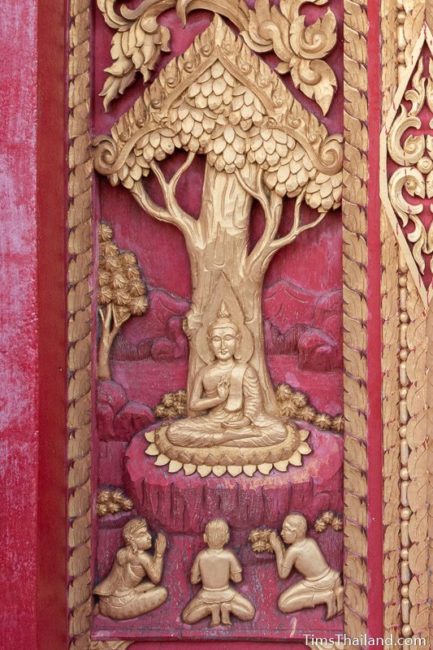
(2) His mother, Queen Phusati, had previously been the queen of Indra, king of the gods, and before her merit was used up and she needed to leave heaven and return to earth, Indra granted her ten wishes; one of which was to have a son who would be a virtuous, respected, and powerful king. She was born as a princess, married the righteous King Sanjaya, and gave birth to Prince Vessantara, the Bodhisatta. He was born free from impurity and immediately after leaving the womb asked his mother to give him something he could give away as a gift: she gave him one thousand coins.
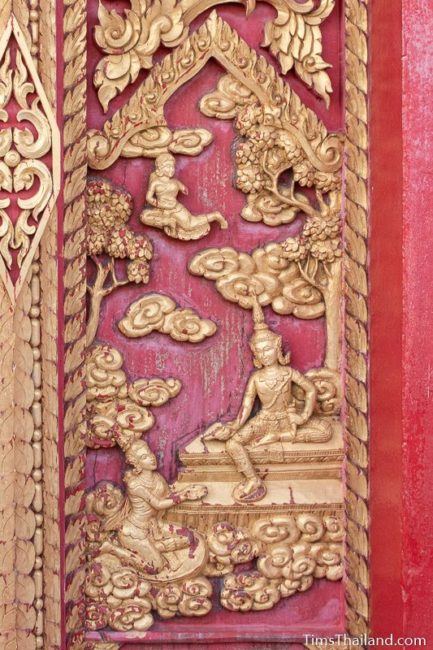
(3) As Prince Vessantara grew up he never stopped giving people things and was so generous that when a rival kingdom wanted to have the prince’s auspicious white elephant, which caused abundant rain to fall, he gave it away without hesitation.
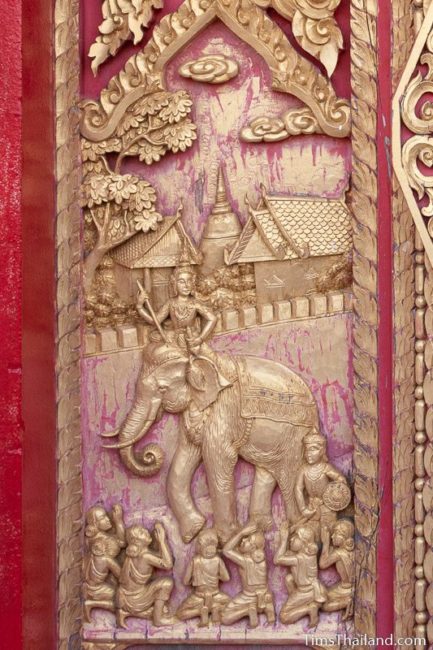
(4) This enraged the citizens who feared the downfall of their kingdom. They demanded King Sanjaya banish Prince Vessantara to a mountain deep in the Himalayas, and the outrage was so widespread that the king had no choice but to comply. Taking his wife Maddi, son Jali, and daughter Kanhajina, he rode out of the city in a gorgeous carriage pulled by four thoroughbred horses.
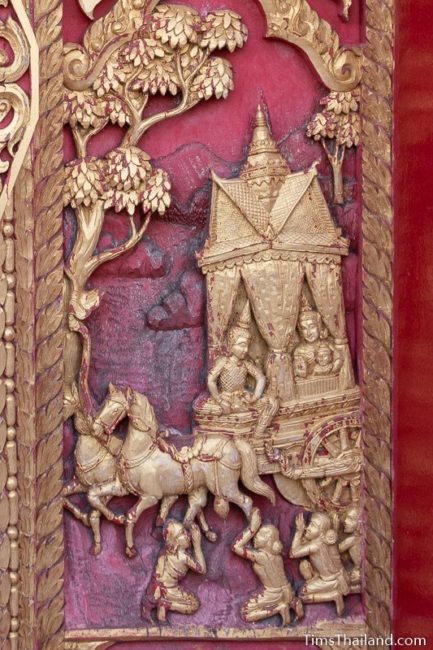
(17) The gods also made Jujaka take a wrong turn which led him to King Sanjaya’s city. The king was overjoyed to see his grandchildren and he bought them from Jujaka. The payment included a seven-story palace. Jujaka lied down on the couch of his new home and gorged himself on fine meats.
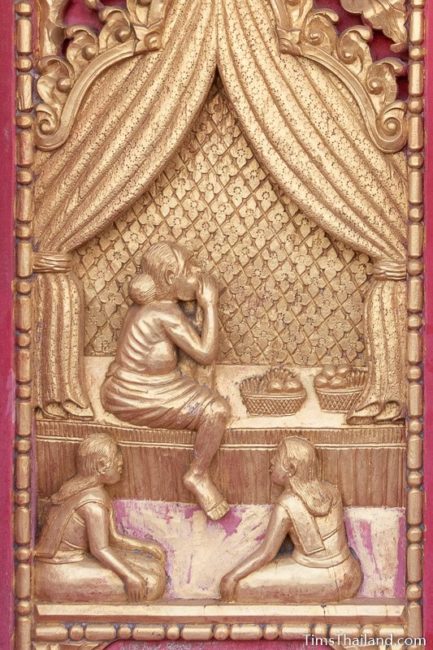
(18) He ate so much that he couldn’t digest the food and died from his gluttony.
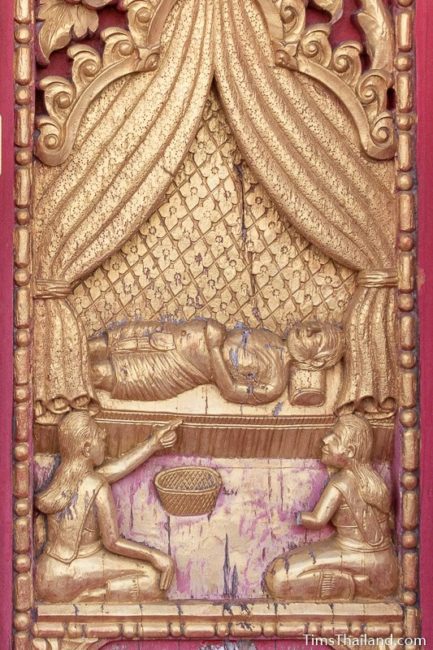
(19) Jali told King Sanjaya about their difficult lives in the forest and he was filled with remorse. The king made the long march to his son’s hut and when the family was reunited everyone fainted. Indra sent a magical rain to revive them and it only fell on those who wanted to get wet.
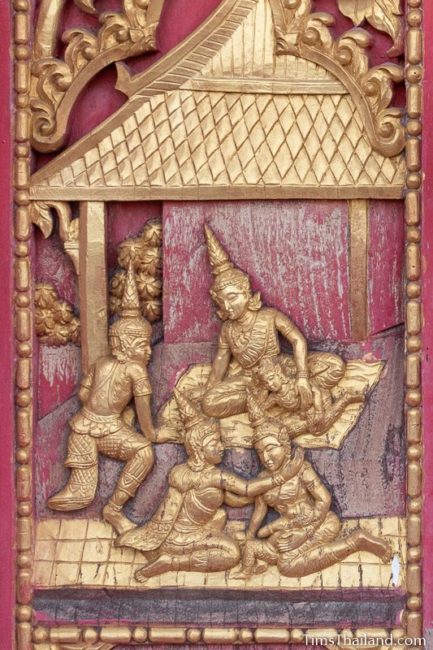
(20) The prince forgave his father, and he invited his son to come back and take the throne. Everybody celebrated at the mountain camp for a month and then Prince Vessantara rode his auspicious white elephant (which had been returned by the other king) home to a hero’s welcome.
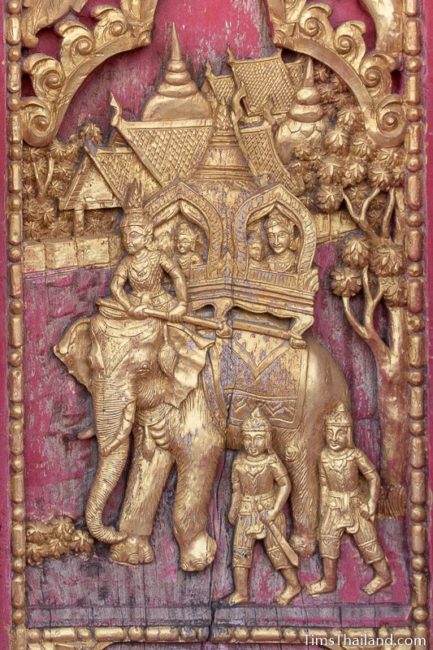
(5) As they traveled the road, people asked for his horses and carriage. Of course he gave them away, so they had to walk. They took up abode in the forest and donned the simple clothes of ascetics.
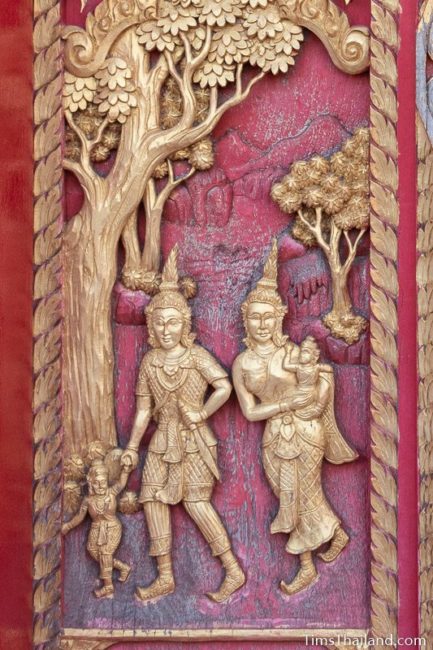
(6) In another kingdom lived Jujaka, a decrepit old brahmin with a very young wife, Amittatapana, who was given to him in lieu of a debt her parents could not repay.
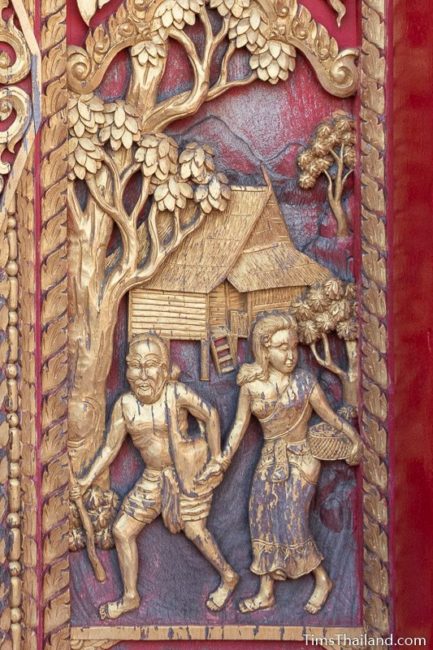
Vessantara Jataka
(เวสสันดรชาดก / Wetsandon Chadok)
The Bodhisatta was once a prince. He was generous to a fault and one time gave away the kingdom’s auspicious white elephant, which guaranteed rainfall, to another kingdom that was suffering a drought. The citizens were so angry they forced his father to banish him, so he and his family went off to live as ascetics in the mountains. There he gave away his children and wife, achieving the supreme perfection of generosity. The elephant and his family were returned and the Bodhisatta was brought back to the city to be king.
• Perfection of character: generosity (dana)
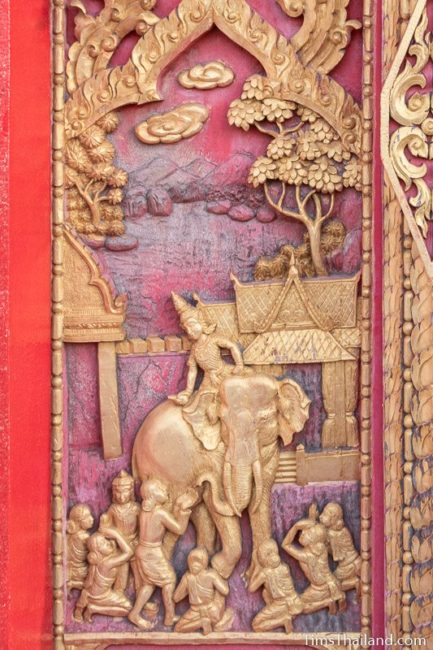
Vidhurapandita Jataka
(วิทูรชาดก / Witoonra Chadok)
The Bodhisatta was once a king’s advisor. Four kings wondered which of them possessed the greatest virtue, and when the Bodhisatta proclaimed them equal, word of his wisdom spread. A queen of the nagas wanted to hear him preach and told her king to bring her the Bodhisatta’s heart. She meant his wisdom, but the king took her words literally and sent a goblin assassin. The goblin won the Bodhisatta from the king in a dice game, but the Bodhisatta converted his would-be killer and survived.
• Perfection of character: truthfulness (sacca)
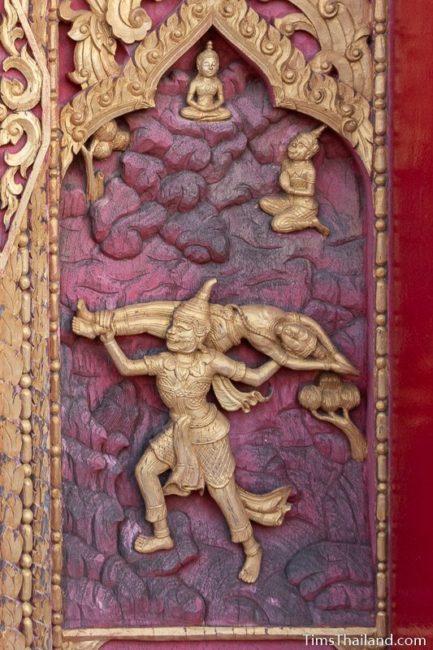
(9) When Jujaka entered the forest, a pack of dogs chased him up a tree. A forester who was ordered to prevent anyone from going to see Prince Vessantara saw Jujaka and was about to kill him, but Jujaka claimed he was a messenger from King Sanjaya come to tell the prince that he was forgiven and could return home. The forester, glad to hear this good news, believed him and let him go.
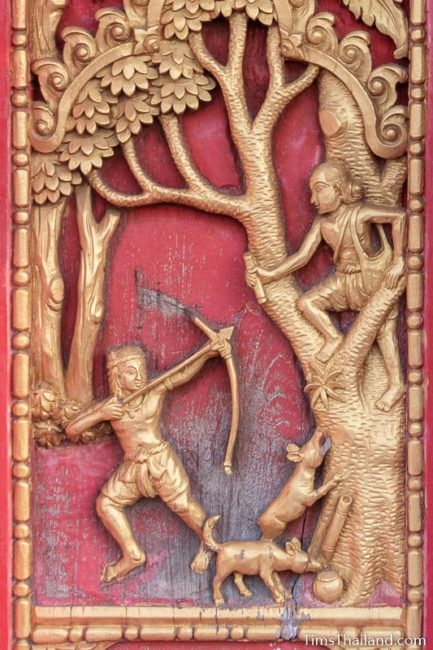
(10) Deeper into the forest, Jujaka stopped to get directions from the ascetic Accuta. Jujaka lied that he was only going to pay respect to the prince and Accuta believed him.
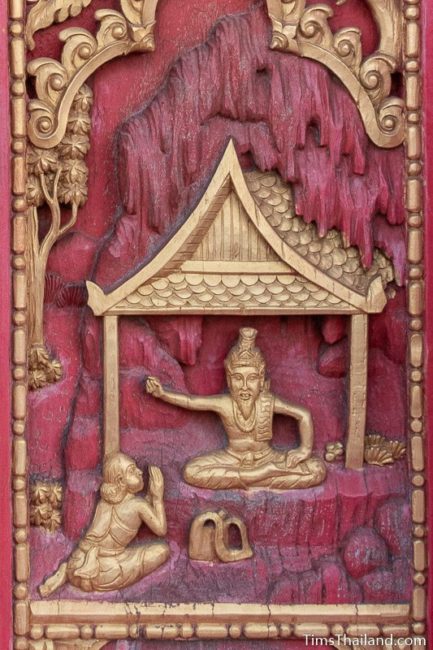
(11) Jujaka found Prince Vessantara, and when Maddi went out to the forest to gather fruits and roots, he approached and asked for the children. Generosity being his nature, Prince Vessantara agreed. The children were listening and went to hide under lily pads, but their father found them and sent them away.
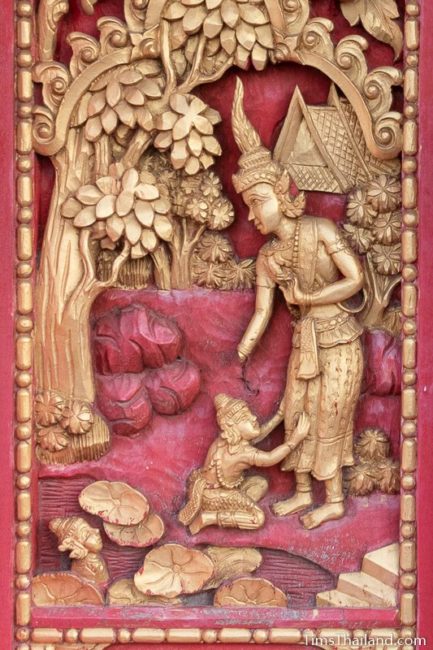
(12) The gods knew that when Maddi came back and found her children gone she would chase after them, and this would get her into trouble. So three of them took the forms of a lion, tiger, and leopard and lie down blocking her path home until after it was dark.
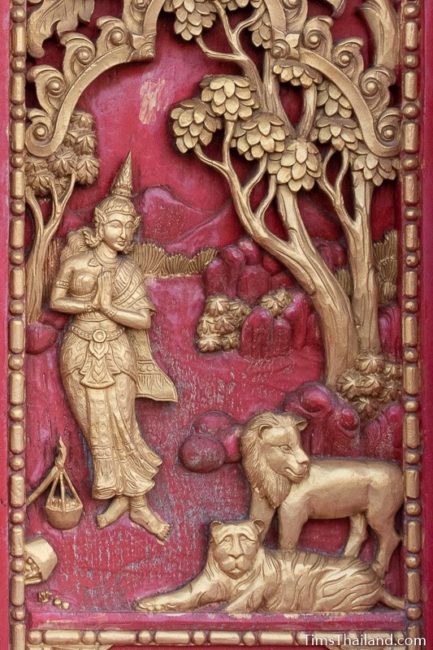
Mahanaradakassapa Jataka
(นารทชาดก / Narata Chadok)
The Bodhisatta was once a god in heaven. On one holy day, a righteous king went to discuss religion with a naked ascetic, and he convinced the king there is no karmic consequence to sin. The king began living his life purely for pleasure and his daughter tried unsuccessfully to sway the king away this false doctrine. Then the Bodhisatta came and his words put the king back on the path of righteousness.
• Perfection of character: equanimity (upekkha)
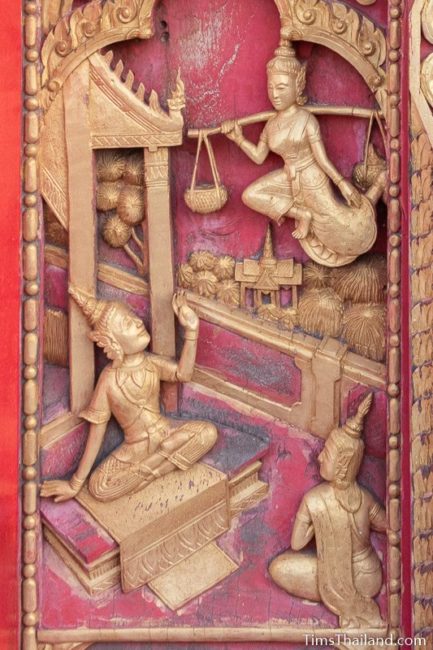
Khandahala Jataka
(จันทกุมารชาดก) / Jantaguman Chadok)
The Bodhisatta was once a crown prince. The king’s chaplain was corrupt, and when the Bodhisatta was appointed judge in his place his bribery income dried up. So the chaplain convinced the king that to get into heaven he needed to sacrifice some of his wives and children. Nobody could change the king’s mind and just as the Bodhisatta was about to become the first victim, Indra came and saved everybody.
• Perfection of character: patience (khanti)
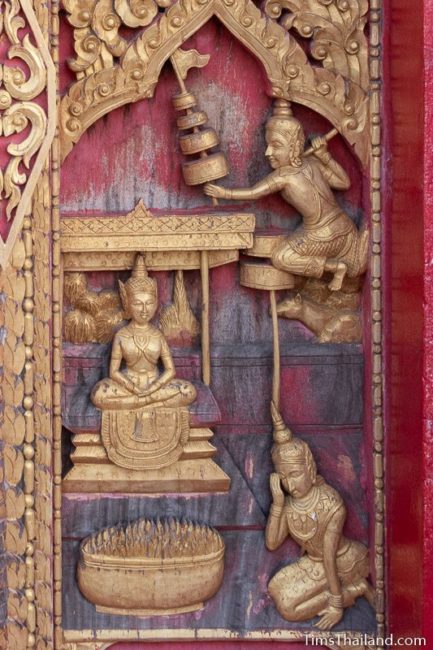
Bhuridatta Jataka
(ภูริทัตชาดก / Puritatda Chadok)
The Bodhisatta was once a naga king. His mother was a human, given as a gift to resolve a feud between his naga father and a human king that was started by a turtle who ran a scam to avoid being unjustly killed. The Bodhisatta was diligent about keeping the holy-day precepts and did so in the human realm where he would not be bothered. He was captured and tortured by a snake-charmer who took away his magic powers with a spell and forced him to perform in shows until his brother rescued him.
• Perfection of character: virtue (sila)
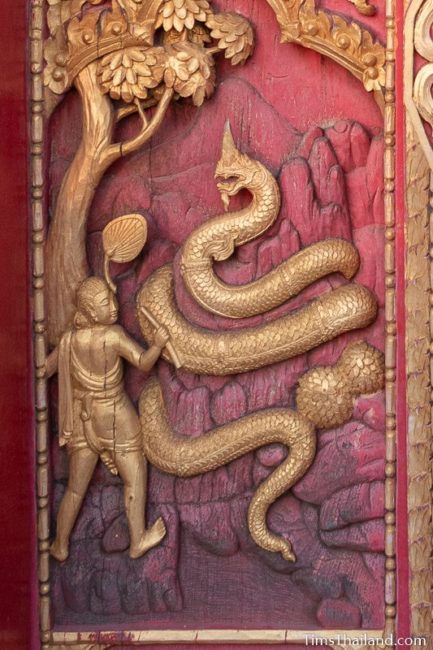
Maha-Ummagga Jataka
(มโหสถชาดก / Mahosot Chadok)
The Bodhisatta was once a king’s advisor. He was so smart he began his career at age seven after performing remarkable feats, fairly settling disputes, and solving difficult challenges. Over the years he always outwitted the other four royal advisors, and in their jealousy they tried to kill him. When a powerful king tried to conquer all of India, the Bodhisatta defeated him through clever schemes. Later the defeated king duped the Bodhisatta’s king with a false promise of marriage to his beautiful daughter and almost managed to kill him, but the Bodhisatta saved him by building a magnificent tunnel. The twice-defeated king repented and respected the Bodhisatta, who later went to work for him.
• Perfection of character: wisdom (panna)
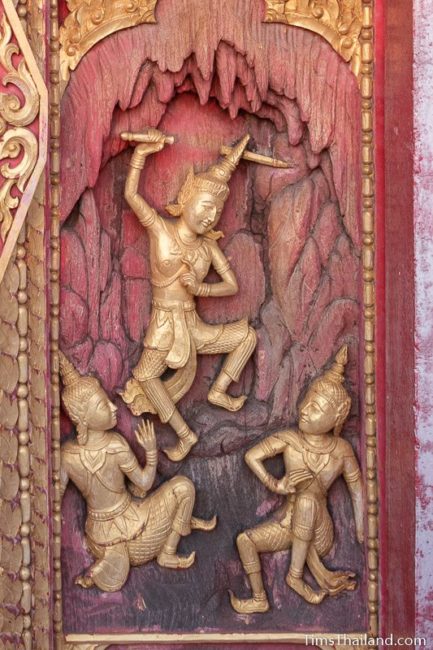
(13) When Maddi got back home and her children were gone she worried they were dead, but Prince Vessantara would not tell her anything. She searched around their home in the light of the full moon, but did not find them.
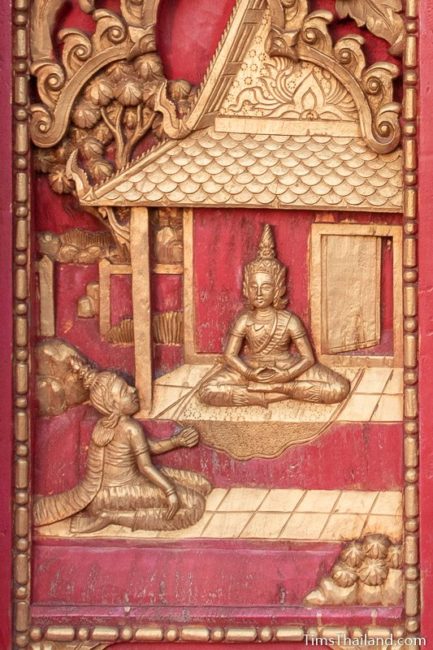
(14) At dawn Prince Vessantara confessed what he had done. Maddi was upset, but understood his compulsion to give charity, so she forgave him.
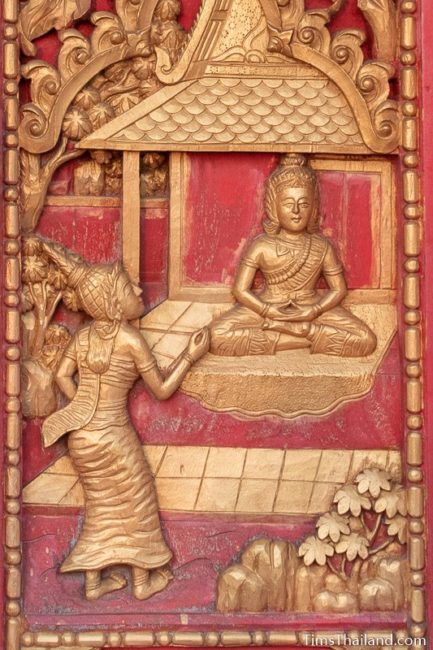
Nimi Jataka
(เนมิราชชาดก / Nemirat Chadok)
The Bodhisatta was once a king. After eighty-four thousand years on the throne he found a grey hair on his head and decided to abdicate and live as an ascetic before going to heaven. The next eighty-four thousand less two generations of his descendants followed the same path through life, but it wasn’t enough to earn nirvana, so the Bodhisatta returned to earth as the present king’s son to ensure the line would be finished. He was uncompromisingly generous and righteous, so Indra invited him to visit heaven, and on the way he took a detour to see hell. After returning to earth he made his son the final king of the family’s cycle.
• Perfection of character: determination (adhitthana)
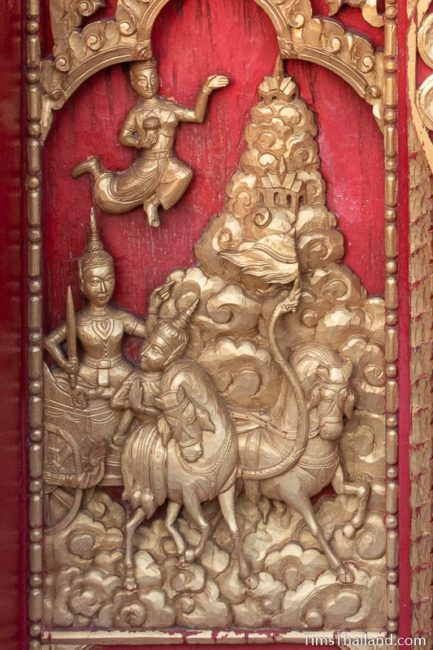
Sama Jataka
(สุวรรณสามชาดก / Suwannasam Chadok)
The Bodhisatta was once a son of two ascetics. Knowing they would go blind someday, Indra gave them a son. While out hunting, the king saw that animals were not afraid of the Bodhisatta and shot him with a poisoned arrow so he could talk to him briefly before he died. With the remorseful king’s help, the Bodhisatta’s parents’ prayers brought him back to life.
• Perfection of character: loving kindness (metta)
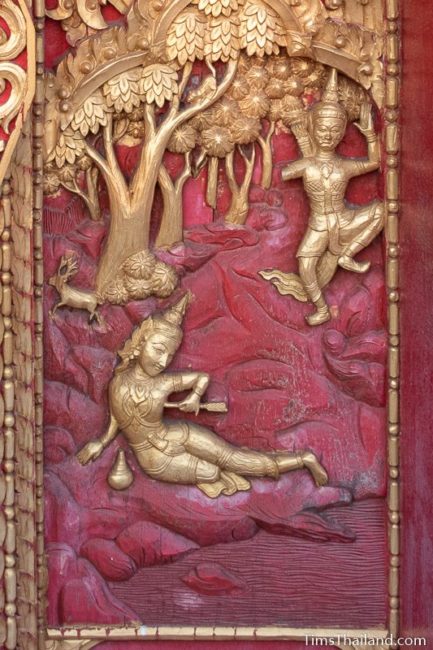
Mahajanaka Jataka
(ชนกชาดก / Chanok Chadok)
The Bodhisatta was once a widowed queen’s son. She fled to safety after her king died in battle. When the Bodhisatta came of age he decided to go to his father’s city and try to become king. The boat he traveled in sank and a goddess rescued him and took him to the kingdom where he was given the throne. After a long rule, the destruction of a mango tree inspired him to become an ascetic.
• Perfection of character: endurance (viriya)
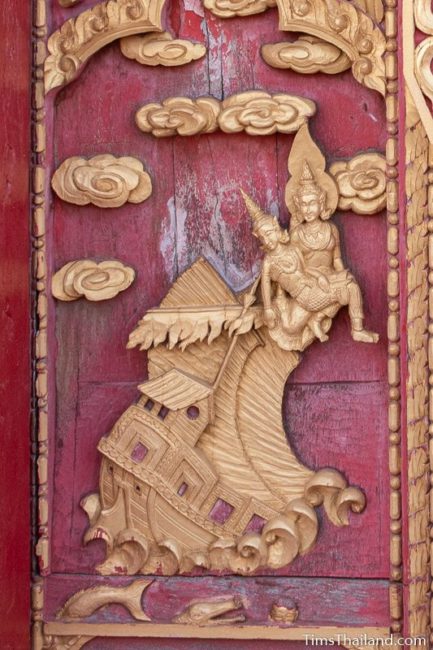
Muga-Pakkha Jataka
(เตมียชาดก / Temi Chadok)
The Bodhisatta was once a crown prince. At one month old he remembered that kings must sometimes be cruel and thus they go to hell. He was an only child and to avoid becoming king he acted disabled, deaf, and mute, even though his parents tricked and tortured him trying to make him respond. When he turned sixteen, the king’s advisors said the Bodhisatta must be killed to avoid bad fortune. After he was taken outside the city and freed from his royal fate, the Bodhisatta got up and told the executioner to bring his parents to see him and they all became ascetics.
• Perfection of character: renunciation (nekkhamma)
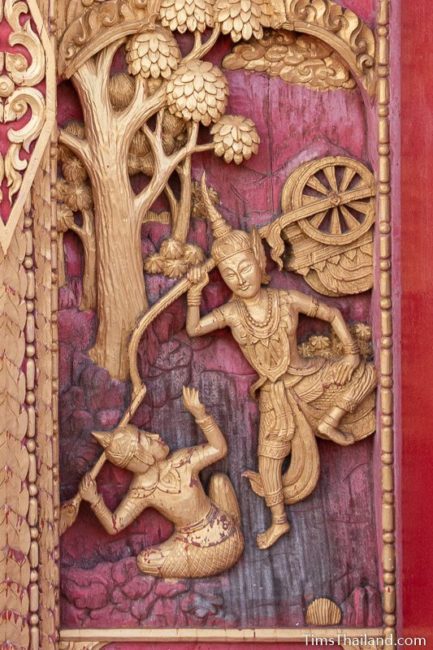
(15) Indra knew that Maddi was the prince’s last possession and he knew he would give her away if someone else came and asked. This would leave him alone and helpless. So Indra took human form and went and asked for her. After Prince Vessantara gave her away, Indra revealed himself and gave her back.
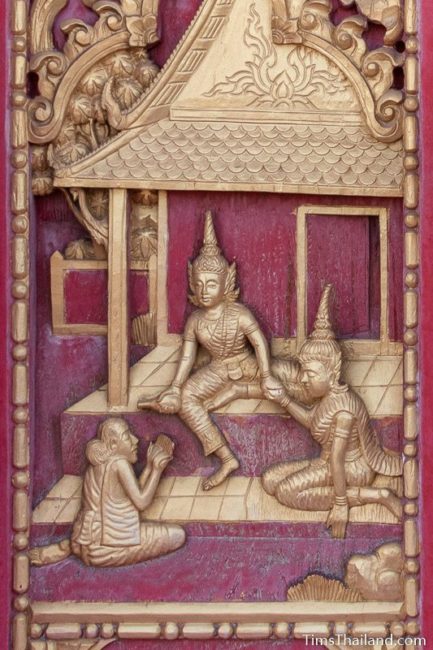
(16) During Jujaka’s walk home he tied the children up on the ground so they couldn’t escape while he slept safely up in a tree, away from wild beasts. When he fell asleep, two gods taking the form of the Prince Vessantara and Maddi untied the children and took care of them.
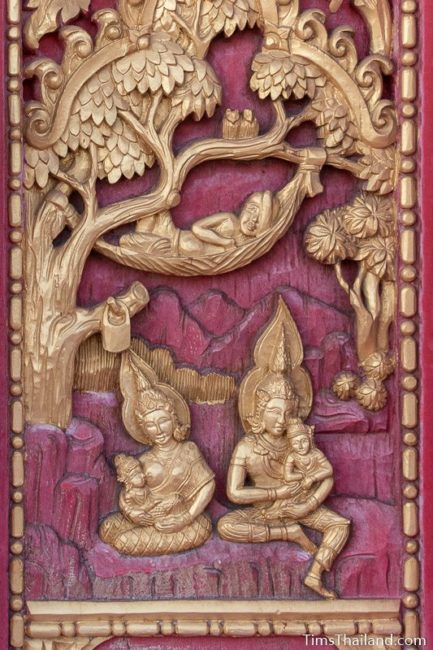
(7) Amittatapana cared for Jujaka so devotedly that some men criticized their own wives for not meeting her standard. These angry women insulted Amittatapana, hoping to make her leave town and return home.
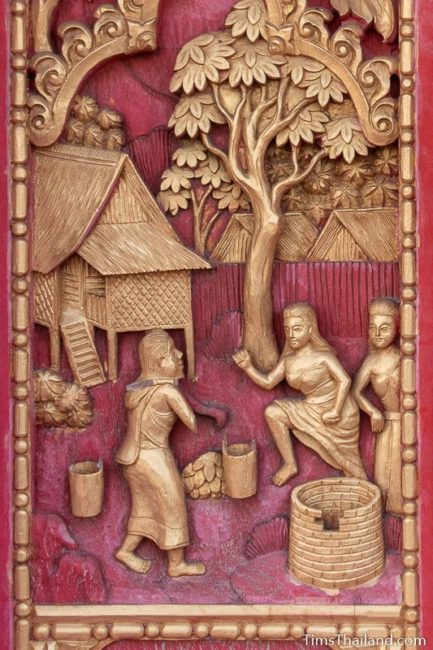
(8) Amittatapana told Jujaka that if she did not get servants or slaves to help her, she would leave. He did not have enough money for this, but she suggested going to the Himalayas and asking Prince Vessantara for his children to become their slaves. (Jujaka walking through the forest with the children tied up so they cannot escape is a famous scene in the Vessantara Jataka. Chronologically it appears later in the story – it could fit in after either #11 or #15 – and we do not know why the artist chose to put it here where it must represent Jujaka and/or Amittatapana imagining it; though it does seem to be his choice rather than an installation error.)
